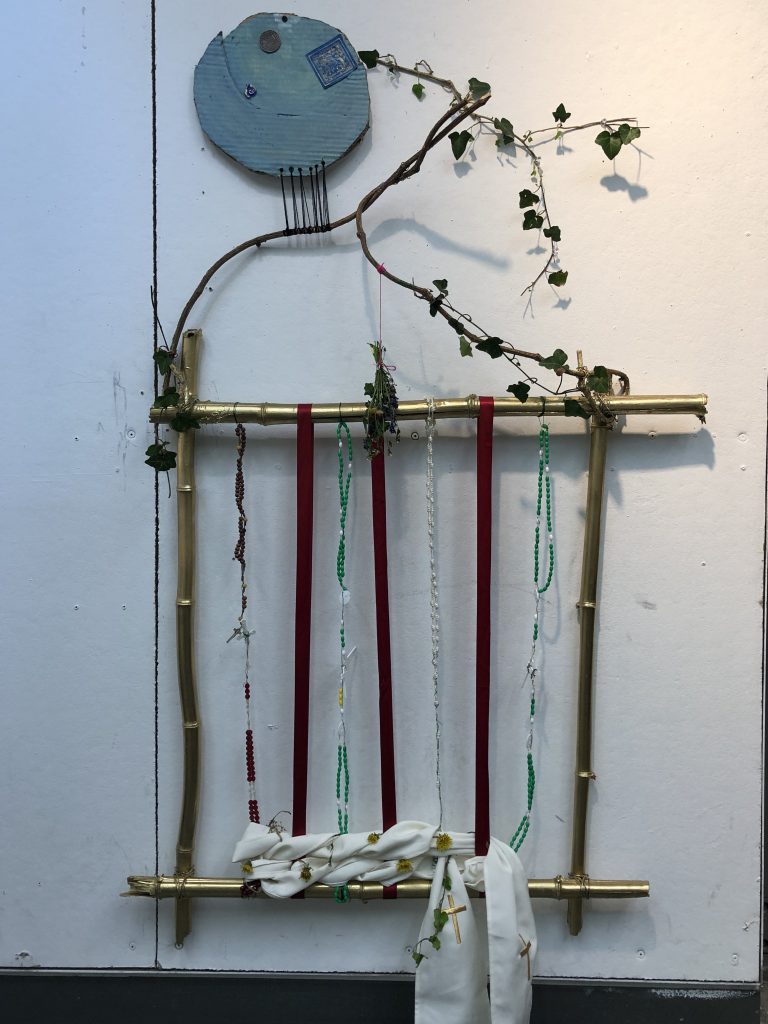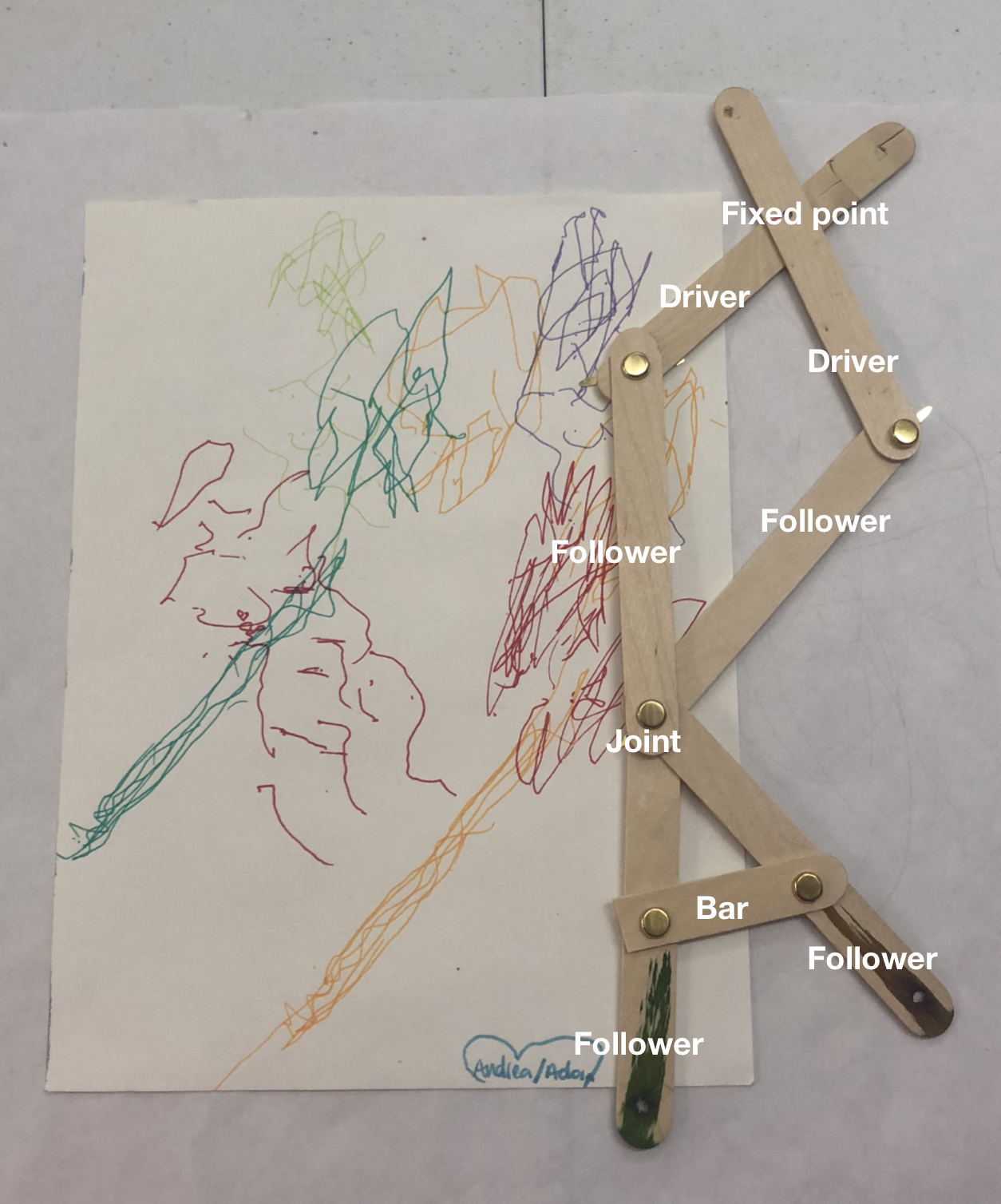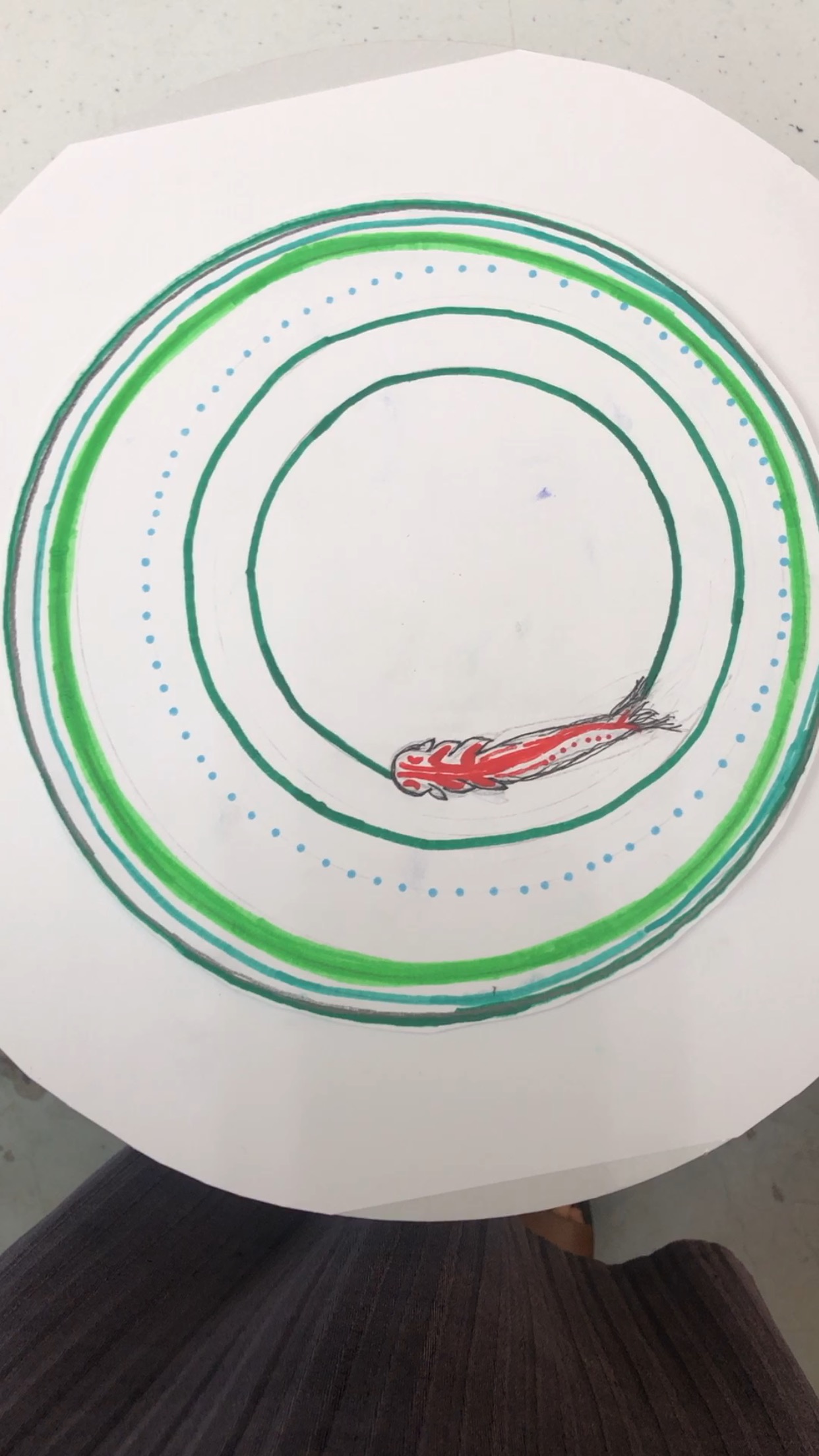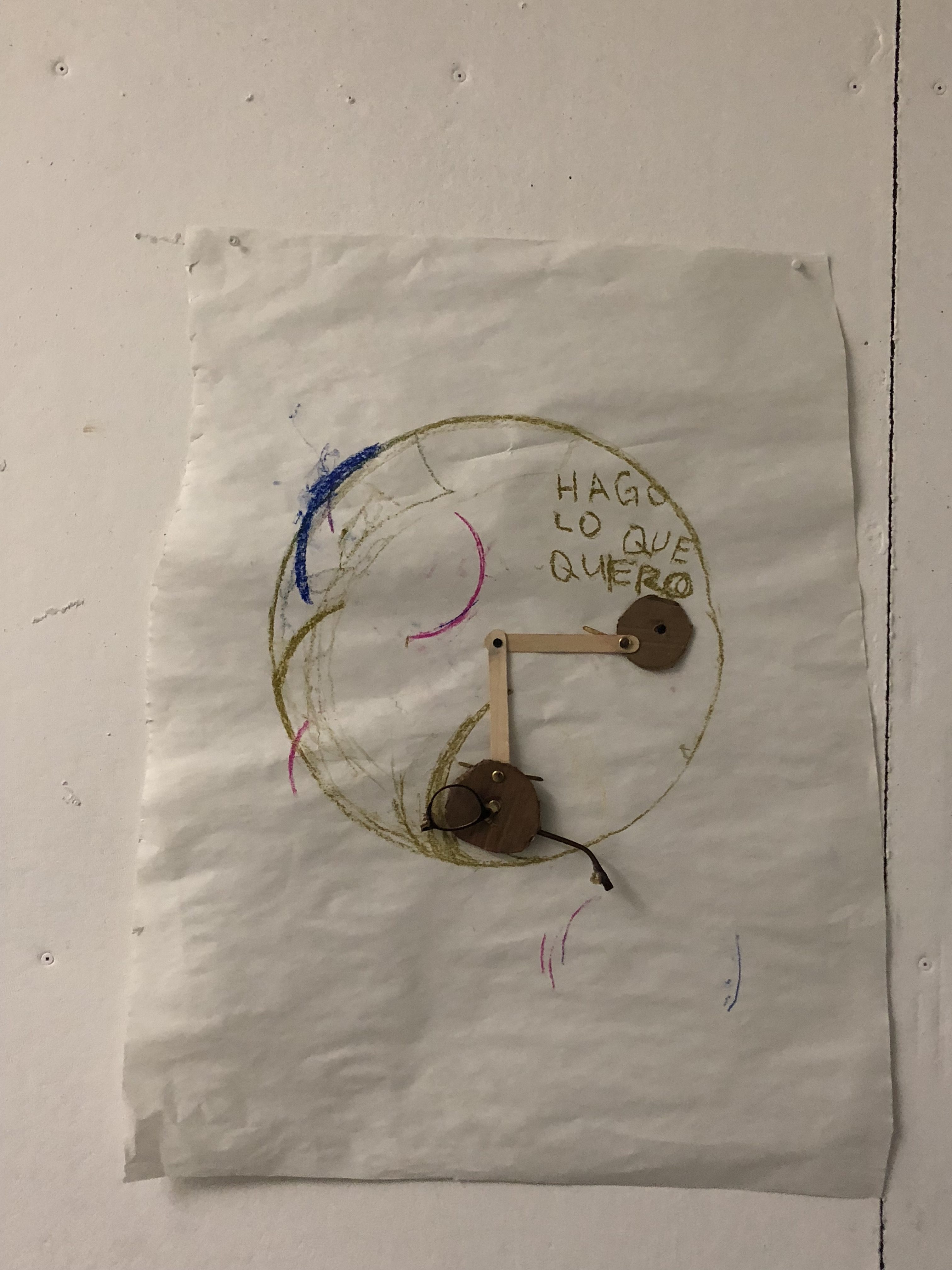
This semester I have chosen to expand on my experimentation with weaving through another handmade loom. I intend to explore the realm of textile and fiber art through a simple frame loom constructed out of bamboo bark. The base structure is made from bamboo collected from Sunnybrook Park behind Marshall Field and assembled with twine and hot glue. I attached the frame to tree branches that are flexibly intertwined so that the loom can be hung indoors or outside amongst trees. Textile art is a unique craft that I personally understand as a form of drawing and generative art.
The loom functions as the technical apparatus through which the act of weaving can be performed, signaling the intervention of a machine to carry out a process which can be traditionally done manually by hand. Textile design is a conscious process carried out by synthesizing visual, aesthetical and applied means. These mechanisms are expressed in the graphic configurations of the ultimate weave. They additionally reflect the subconscious process through which the designer can express their inner world shaped and characterized by a subjective identity. The use of particular designs often reflects traditional beliefs, customs, and hierarchies, underpinned by transcendent spiritual meanings.

Textile art and design should be reconsidered within the framework of new media. Weaving is a binary art that applies operations of pattern algebra and is widely regarded as a precursor to computational thinking. My own machine weaves natural materials such as twigs, branches, dried flowers, ivy and other plant cuttings. I intend to explore methods to engage spectators by creating processes in which they can collaboratively create a weave through joint communal motions.
The loom, as articulated by Andreas Broeckmann in “Machine Art of the Twentieth Century” evokes a particularity in how the object, mechanism, and process of weaving designates a relationship between humanity and the material world. In Ancient Andean tradition, weaving was of particular importance to indigenous nobility and quintessential to its civilizations as fine textile garments testified to wealth and class status. It can additionally be situated within Andean cosmological traditions, often understood as falling under the dominion of the Moon – the celestial object invoked as the creator of women. Acllas, or women weavers and food preparers in Inca administrative centers, worshipped the Moon’s generative powers and her dominion over femininity.
The origins of this project lay within my discovery of Bauhaus student (and professor at the experimental Black Mountain College) Anni Albers. She embraces close handwork with textiles to establish familiarity with the fundamental material elements of the woven object. Albers sought to renew a direct, manual contact with materials through work at the loom and defended traditional handwork to experiment within its tactile constraints. She saw mechanized tools and machines as a sort of creative guide that could reveal how materials change their character in certain constructions and simultaneously how construction is affected by the material. To Albers, the machine displays how an artist can support the characteristics of material or suppress them, depending on the form of construction they use.

Last semester I was quickly drawn to textile work because of its precision and vast potential for innovation through experimentation. It coincided with another research project of mine on pre-Columbian Andean labor politics and gender ideologies that has effectively nurtured a deep sense of interconnection to the process of weaving within me. As I explore my relationship with the loom, I envision a more intimate process of ancestral healing and acknowledging the sophisticated beauty of indigenous traditions, many of which are exploited by the legacy of colonization.
I intend to use repetition as a driving force in my project considering weaving’s foundational use of pattern algebra. As I experiment with the frame I’ve developed so far, I hope to integrate motion by playing with gravity and the loom’s relationship to space. I want to utilize its large scale to nurture a sense of collaboration between the machine and the spectator. I plan to design a mechanism that allows viewers to input a motion that in turn generates an additional weft. This can be accomplished by adding a shuttle stick which inserts weft yarns through the back-and-forth motion of the shuttle. The shuttle simplifies the process by carrying the weft yarn through the warp yarn shed to forming interlacement to produce fabric instead of doing it manually. These ideas were developed largely in response to our conference meetings as I was asked to consider my project’s functional use more extensively, while expanding on its symbolic meaning.

After being asked to depart from the traditional framework of a simple loom, I decided to experiment with my use of materials for the weft- the longitudinal thread running down the woven fabric. I swapped yarn for rosaries after examining reoccuring themes within the tangible spaces I inhabit. After struggling to find something I could use in my dorm room, I drew my inspiration from my mother’s house in Queens. My mom is a devout Roman Catholic immigrant from Colombia. Thus I was raised in a strict traditional household structured around my parent’s religious beliefs and moral values. Our small apartment is adorned by Medieval, Gothic, and Renaissance relics that my mom collects religiously. I have vivid memories of the countless rosaries I recited alongside my mom at home, in prayer groups at church, in gatherings at other people’s homes, during car rides on road trips, while we boarded an airplane.
I am drawn to the symbolic weight of the weave and how particular material and graphic choices articulate the artist’s subjective perception of the world. The aesthetic choice to incorporate sacred prayer objects from Roman Catholicism is an intimate look into my upbringing. I was raised around deeply spiritual people who genuinely derived their will to persist and their understanding of existence from their identification with Christianity. When I was younger, I understood faith as a communal mechanism of survival in an unstable, chaotic world. Now that I am more versed in the historical role played by the Catholic Church, institutionalized religion has a much more cynical connotation.
Rosaries are evocative of a distinct denomination which I thought to juxtapose against the theme of weaving as an indigenous tradition. This marked a distinct shift of artistic focus away from the functional mechanisms I initially imagined I would incorporate in the final iteration of my work. It has taken on a loaded political message instead, speaking to the hybridity of spiritual traditions in Latin America particularly reflecting the intersections of Andean cosmological rituals and Roman Catholic idolatry. It also ushered in new set of complications regarding its operational functions and whether the apparatus even constitutes a loom. It can be used to weave, but the process requires a manual, tactile engagement with the given material. This was a conscious risk I took in incorporating the plastic beads as the material basis for the weft to expand the conceptual value of the drawing machine.

I personally can draw specific connections between each of my aesthetic choices, but I recognize the dissonance between some of the materials I integrated into the project. I was trying to respond back to requests to create cohesion between the transgression on Catholicism and the invocation of Andean cosmology. I took into careful consideration what was discussed in conference meetings to mainly develop my commentary on cultural intersections and exchanges between Andean understandings of the divine within a cosmological framework and the role of the Catholic Church in colonization. I revisited my work last semester with a lunar object to reference the Andean tradition of worshipping the earth and natural deities as embodiments of divinity. The arrival of Spanish conquistadors to sovereign indigenous territory marks the attempt at cultural genocide and forced conversion of mass communities to Christianity. My loom is meant to speak to how Andean customs were consequently adapted and disguised as appropriate Christian rituals, while Pachamama or Mother Earth, remained their true deity.
Ultimately, there were aesthetic choices I made to construct a conceptual narrative that is personal to my own spiritual journey and reflects close introspection surrounding the consequences and historical context of my upbringing. I struggled to tie it all together cohesively while working within the constraints of limited materials and studio time. I worked on this predominantly in my dorm room and outdoors, so there were definitely limits to how it could develop. I am overall proud of the conceptual depth I considered when making this, although I hope it is effectively communicated to spectators.


